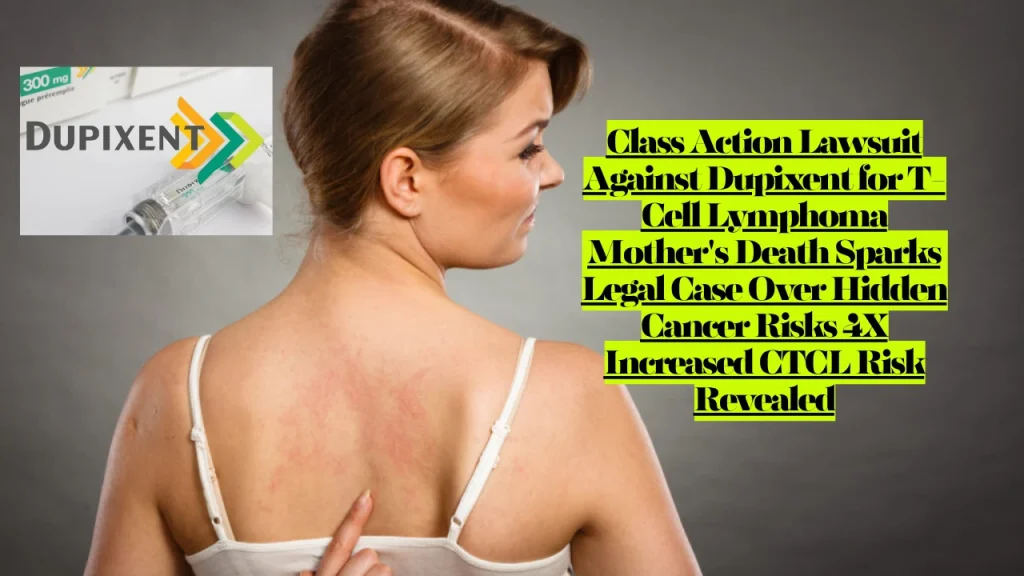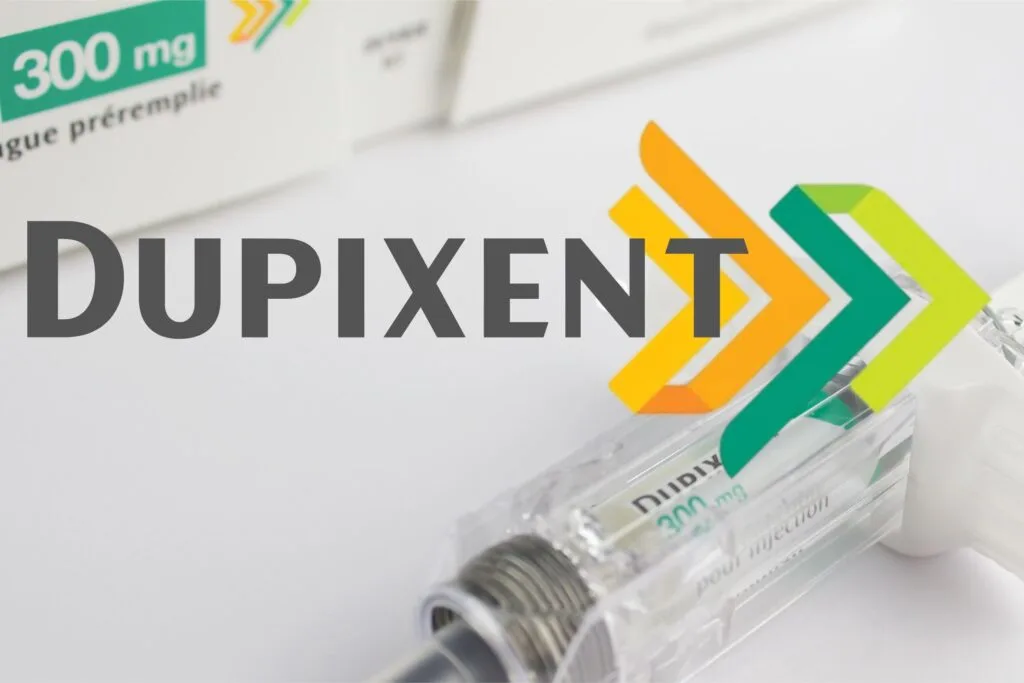Class Action Lawsuit Against Dupixent for T-Cell Lymphoma Mother’s Death Sparks Legal Case Over Hidden Cancer Risks 4X Increased CTCL Risk
Breaking Legal Update: A Tennessee wrongful death lawsuit has thrust Dupixent—used by millions for eczema and asthma—into the national spotlight after a patient’s fatal diagnosis of T-cell lymphoma. Research from 2024 reveals patients with atopic dermatitis treated with dupilumab (Dupixent) face three to four times higher risk of developing cutaneous T-cell lymphoma (CTCL) compared to non-exposed patients.
As of October 2025, legal investigations are accelerating nationwide, with the FDA identifying CTCL as a “potential signal of a serious risk” associated with Dupixent in early 2024. This comprehensive analysis examines the critical legal developments, medical evidence, and your rights if you or a loved one developed cancer after using this blockbuster medication.
What’s Happening: The Tennessee Wrongful Death Case That Changed Everything
The daughter of a Tennessee woman has filed a wrongful death lawsuit against the makers of Dupixent after her mother died from T-cell lymphoma allegedly caused or exacerbated by the inflammatory treatment, with the complaint filed in October 2024. This case represents the first wrongful death claim in what legal experts predict could become widespread litigation against manufacturers Sanofi and Regeneron Pharmaceuticals.
The lawsuit centers on allegations that Dupixent either triggered new cancer development or masked existing CTCL symptoms while allowing the disease to progress undetected—ultimately resulting in death.
The Alarming Statistics: 410% Increased Cancer Risk
Multiple peer-reviewed studies published in 2024-2025 have documented shocking correlations between Dupixent use and cancer development:
Key Research Findings
4.1-Fold Risk Increase: Patients with atopic dermatitis who used Dupixent had a 4.1-fold higher risk of developing CTCL compared to those who did not, with most cases diagnosed more than a year after treatment began.
Timeline Data: According to a 2024 study in Dermatologic Therapy, most Dupixent patients who developed CTCL were diagnosed within the first year, with higher risk in patients over age 60.
Delayed Diagnosis Danger: The cancer often goes undetected because its symptoms—skin rashes, patches, and lesions—mirror the eczema that Dupixent is prescribed to treat. Medical experts believe Dupixent may unmask undiagnosed CTCL by suppressing eczema-like symptoms, making the cancer more visible only after progression.
Table of Contents
What Is Cutaneous T-Cell Lymphoma (CTCL)?
Cutaneous T-cell lymphoma is a rare, aggressive form of non-Hodgkin’s lymphoma that begins in white blood cells called T-lymphocytes and primarily affects the skin. Unlike many cancers, CTCL often presents initially as:
- Persistent skin patches or plaques that don’t respond to treatment
- Red, scaly rashes resembling eczema or psoriasis
- Thickened skin areas
- Tumors or nodules on the skin
- Severe itching that worsens over time
The insidious nature of CTCL makes it particularly dangerous for Dupixent patients. Because both eczema and early-stage CTCL cause similar skin manifestations, patients and physicians may mistake cancer symptoms for treatment-resistant dermatitis, delaying critical diagnosis and intervention.

The Core Legal Allegations: What Manufacturers Knew and When
Lawsuits are being investigated alleging that Sanofi and Regeneron failed to warn about potential risks of immune suppression and delayed cancer diagnosis. Legal claims focus on three primary theories of liability:
1. Failure to Warn (Inadequate Labeling)
As of current reports, Dupixent’s label includes no warning of potential cancer risk, despite ongoing regulatory review. Plaintiffs argue manufacturers possessed safety data about CTCL risks but failed to update prescribing information or notify physicians and patients.
Under federal drug law (21 U.S.C. § 355), pharmaceutical companies have continuing obligations to report adverse events and update labeling when new safety information emerges.
2. Design Defect and Product Liability
Plaintiffs contend that Dupixent’s mechanism—suppressing immune responses through interleukin-4 receptor blockade—creates inherent cancer development or unmasking risks that outweigh therapeutic benefits for certain patient populations.
3. Negligence in Post-Market Surveillance
Legal arguments assert manufacturers failed to adequately monitor real-world safety data, conduct appropriate studies when warning signals emerged, and take corrective action despite accumulating evidence of CTCL associations.
Timeline of Evidence: When Did Red Flags First Appear?
2019: Initial peer-reviewed studies and published case reports began raising concerns about Dupixent’s association with increased cutaneous T-cell lymphoma risk, with early warnings from individual patient case studies.
2024 (April): A landmark study published in JAMA Dermatology on April 6, 2024, found patients with atopic dermatitis treated with Dupixent faced sharply elevated CTCL risk after analyzing large health records and controlling for age, sex, and race.
2024 (Q4): The FDA reviewed its Adverse Event Reporting System (FAERS) by late 2024, finding sufficient cases to issue a new safety signal in March 2025.
2024 (October): The first wrongful death lawsuit was filed in Tennessee, marking the beginning of anticipated mass tort litigation.
2025 (Present): The FDA placed Dupixent on its watch list for potential regulatory action in late 2024, though as of August 2025, the agency has not released an update on its evaluation.
Current Legal Landscape: What’s Happening Now
Case Status
Multiple law firms nationwide are investigating and filing individual lawsuits on behalf of Dupixent users diagnosed with CTCL or other T-cell lymphomas. As of October 2025, litigation remains in early stages, with no Multi-District Litigation (MDL) or class action established yet—though legal experts anticipate consolidation as cases proliferate.
Who Qualifies for Legal Action?
You may be eligible to pursue a Dupixent lawsuit if:
- You were prescribed and used Dupixent (dupilumab) for atopic dermatitis, asthma, chronic rhinosinusitis with nasal polyposis, eosinophilic esophagitis, or prurigo nodularis
- You were subsequently diagnosed with cutaneous T-cell lymphoma (CTCL), mycosis fungoides, Sézary syndrome, or other T-cell lymphoma variants
- Your diagnosis occurred during Dupixent treatment or within several years after use
- You suffered significant medical complications, required intensive treatment, or a loved one died from T-cell lymphoma
- Your claims fall within your state’s statute of limitations (typically 2-4 years from diagnosis or discovery)
Statute of Limitations Considerations
Under Tennessee Code § 20-5-106 and § 20-5-113, wrongful death claims must generally be filed within one year of the death. Product liability claims typically have longer windows—2-3 years from injury discovery in most states—but consultation with legal counsel immediately upon diagnosis is critical to preserve your rights.

Potential Compensation: What Damages Can Victims Recover?
Patients and families may be entitled to pursue compensation for medical bills, lost income, pain and suffering, and wrongful death. Specific recoverable damages in Dupixent CTCL lawsuits may include:
Economic Damages
- Past and Future Medical Expenses: Cancer treatment costs including chemotherapy, radiation, immunotherapy, stem cell transplants, hospitalizations, and ongoing monitoring
- Lost Wages and Earning Capacity: Income lost during treatment and reduced future earning potential due to disability
- Out-of-Pocket Costs: Travel for treatment, home healthcare, medical equipment, prescription medications
Non-Economic Damages
- Pain and Suffering: Physical pain, emotional distress, mental anguish from cancer diagnosis and treatment
- Loss of Quality of Life: Diminished ability to enjoy activities, relationships, and life experiences
- Disfigurement and Scarring: Permanent skin changes, surgical scars, and physical appearance impacts
- Loss of Consortium: Compensation for spouses whose relationships suffered due to the injury
Wrongful Death Damages
For families who lost loved ones to Dupixent-related cancer:
- Loss of companionship and support
- Funeral and burial expenses
- Estate and survivor losses
- Conscious pain and suffering before death
Tennessee wrongful death law previously capped non-economic damages at $750,000, though recent legal developments have challenged these limitations in cases involving egregious pharmaceutical negligence.
Expert Medical Analysis: Why Dupixent May Cause or Unmask CTCL
Leading dermatologists and oncologists have proposed several mechanisms by which Dupixent might increase CTCL risk:
Immune Dysregulation Theory
Dupixent (dupilumab) works by blocking interleukin-4 and interleukin-13 signaling pathways, which modulate immune responses. This interference may:
- Disrupt normal immune surveillance that prevents cancer cell proliferation
- Reduce the body’s ability to recognize and eliminate malignant T-cells
- Create an environment where existing precancerous cells can progress
The “Unmasking” Phenomenon
Because early CTCL symptoms mimic common skin conditions, the cancer is often misdiagnosed or diagnosed late. Dupixent’s effectiveness in clearing eczema symptoms may paradoxically reveal underlying CTCL that was previously obscured—but by the time cancer becomes clinically apparent, it may have significantly advanced.
Age-Related Vulnerability
Research indicates higher CTCL risk in Dupixent patients over age 60, suggesting older adults’ immune systems may be particularly susceptible to the drug’s immunomodulatory effects.
FDA Response and Regulatory Action: What the Government Is Doing
In early 2024, the FDA identified CTCL as a “potential signal of a serious risk” associated with Dupixent and announced evaluation of whether regulatory action is needed. This designation through the FDA Adverse Event Reporting System (FAERS) indicates the agency has detected a concerning pattern but has not yet concluded whether a definitive causal relationship exists.
What an FDA Safety Signal Means
An FDA safety signal does not constitute proof of causation, but represents:
- Sufficient adverse event reports to warrant investigation
- Biological plausibility of the drug-injury connection
- Potential for regulatory consequences including:
- Mandatory label changes
- Black box warnings
- Risk Evaluation and Mitigation Strategies (REMS)
- Market withdrawal (in severe cases)
Current Status
As of August 2025, the FDA has not released an update on its evaluation despite placing Dupixent on its watch list in late 2024. This regulatory uncertainty creates challenges for both patients currently using Dupixent and plaintiffs pursuing legal claims.
What Should Current Dupixent Users Do? Critical Action Steps
If you’re currently taking Dupixent or have used it previously, take these immediate steps:
1. Do NOT Stop Medication Without Medical Consultation
Abruptly discontinuing Dupixent without physician guidance may cause disease flares or withdrawal effects. Schedule an urgent appointment with your prescribing doctor to discuss risks and alternatives.
2. Document Your Treatment History
Gather and preserve:
- Prescription records showing Dupixent start and end dates
- Medical records documenting your diagnosis and treatment response
- Photographs of any unusual skin changes
- Communication with healthcare providers about side effects
3. Seek Immediate Evaluation for Warning Signs
Contact your physician urgently if you develop:
- New skin lesions or patches that don’t improve
- Worsening rash despite Dupixent treatment
- Enlarged lymph nodes
- Unexplained fatigue or night sweats
- Persistent itching that intensifies
4. Request CTCL Screening
Ask your dermatologist about:
- Comprehensive skin examination
- Skin biopsy if suspicious lesions exist
- Blood tests including complete blood count and flow cytometry
- Referral to a dermatopathologist experienced in CTCL diagnosis

5. Consult a Product Liability Attorney
Speak with a lawyer experienced in pharmaceutical litigation to:
- Understand your legal rights
- Preserve evidence before statute of limitations expires
- Determine case eligibility
- Explore compensation options
Critical Time Consideration: Most states impose strict time limits (statutes of limitation) ranging from 1-4 years from diagnosis or injury discovery. Delays in legal consultation may permanently forfeit your right to compensation.
Comparison to Other Pharmaceutical Litigation: Historical Context
The Dupixent situation parallels several previous pharmaceutical controversies where initial marketing preceded widespread recognition of serious risks:
Vioxx (Rofecoxib)
The arthritis medication Vioxx was withdrawn in 2004 after studies revealed doubled heart attack and stroke risks. Manufacturer Merck ultimately paid $4.85 billion to settle approximately 50,000 lawsuits.
Xarelto (Rivaroxaban)
The blood thinner Xarelto faced litigation over uncontrollable bleeding risks allegedly downplayed by manufacturers. Thousands of lawsuits resulted in confidential settlements.
Invokana (Canagliflozin)
This diabetes drug spawned mass tort litigation over amputation, kidney failure, and ketoacidosis risks. Johnson & Johnson faced claims that inadequate warnings delayed recognition of severe complications.
The common thread: pharmaceutical companies allegedly prioritized commercial interests over patient safety, failing to adequately warn about emerging risks even as evidence accumulated.
Dupixent by the Numbers: Understanding the Drug’s Reach
Approval and Usage:
- FDA approved in 2017 for atopic dermatitis
- Expanded indications for asthma (2018), chronic rhinosinusitis with nasal polyposis (2019), eosinophilic esophagitis (2022), and prurigo nodularis (2022)
- Used by millions of patients worldwide
- 2023 global sales exceeded $11 billion (Sanofi/Regeneron)
Treatment Protocol:
- Administered as subcutaneous injection
- Typical dosing: 600 mg initial dose, followed by 300 mg every two weeks
- Long-term treatment common for chronic conditions
- Often continued for months or years
Patient Demographics:
- Prescribed across all age groups (approved for patients 6 months and older for certain indications)
- Higher usage in patients with moderate-to-severe atopic dermatitis unresponsive to conventional treatments
- Significant population of older adults—the demographic showing highest CTCL risk
Legal Theories and Precedents: The Foundation for Dupixent Claims
Product Liability Law Fundamentals
Under both federal and state law, pharmaceutical manufacturers bear strict duties to:
Duty to Warn (Learned Intermediary Doctrine): Manufacturers must provide adequate warnings to physicians about known or reasonably knowable risks. The “learned intermediary” doctrine holds that manufacturers fulfill their duty by warning doctors, who then inform patients. However, failure to warn physicians constitutes actionable negligence.
Continuing Duty: Unlike one-time product sales, prescription drugs carry ongoing obligations. As new safety data emerges post-approval, manufacturers must update labeling and issue safety communications. 21 C.F.R. § 314.80 mandates reporting adverse events to the FDA within specific timeframes.
Strict Liability for Design Defects: In many jurisdictions, manufacturers can be held liable without proof of negligence if their product’s risks outweigh benefits for its intended use.
Key Legal Precedents
Wyeth v. Levine (2009): The U.S. Supreme Court held that FDA approval does not preempt state law failure-to-warn claims. Plaintiffs can sue even if manufacturers complied with FDA-approved labeling if evidence shows they possessed information warranting stronger warnings.
PLIVA, Inc. v. Mensing (2011): Generic drug manufacturers have limited flexibility to change labeling, but brand-name manufacturers like Sanofi and Regeneron retain responsibility for label adequacy.
These precedents establish that Dupixent plaintiffs need not prove FDA violations—only that manufacturers failed to exercise reasonable care in warning about risks their data revealed.
Understanding Your Legal Rights: Consumer Protection Framework
Federal Protections
FDA Adverse Event Reporting: Under the FDA Amendments Act of 2007, consumers can directly report suspected drug injuries through MedWatch (www.fda.gov/medwatch). While not required for filing lawsuits, reports strengthen the regulatory record documenting Dupixent’s safety issues.
Freedom of Information Act (FOIA): Patients and attorneys can request FDA documents about Dupixent, including adverse event data, internal agency communications, and manufacturer correspondence. This transparency enables plaintiffs to access evidence supporting their claims.
State Consumer Protection Laws
Most states provide additional remedies beyond federal law:
Deceptive Trade Practices Acts: Many jurisdictions prohibit misleading marketing or failure to disclose material risks, enabling claims beyond traditional product liability.
Punitive Damages Availability: If manufacturers acted with reckless disregard for patient safety, courts may award punitive damages designed to punish misconduct and deter future violations. These can significantly exceed compensatory damages.
Wrongful Death Statutes: Each state defines who can file wrongful death claims (typically spouses, children, and parents) and what damages are recoverable. Tennessee Code § 20-5-106 and § 20-5-113 govern such claims in Tennessee, where the first Dupixent wrongful death lawsuit was filed.
Frequently Asked Questions (FAQ)
What should I do if I was diagnosed with CTCL after using Dupixent?
Immediately consult with both your medical team and a product liability attorney. Document your diagnosis, preserve all medical records, and do not destroy any medication packaging or documentation. Time limits for filing legal claims vary by state but typically range from 1-4 years.
Does the FDA warning mean Dupixent definitely causes cancer?
No. An FDA safety signal indicates a concerning pattern that warrants investigation but does not prove causation. However, the FDA identified CTCL as a “potential signal of a serious risk” associated with Dupixent in early 2024, which combined with multiple peer-reviewed studies provides the evidentiary foundation for legal claims.
Can I join a class action lawsuit against Dupixent manufacturers?
As of October 2025, no class action certification exists for Dupixent CTCL claims. Litigation is proceeding through individual lawsuits, though consolidation into Multi-District Litigation (MDL) may occur as cases proliferate. An MDL coordinates pretrial proceedings while preserving individual case characteristics.
How long does a pharmaceutical lawsuit typically take?
Complex pharmaceutical litigation often spans 2-5 years or longer from initial filing to resolution. Factors affecting timeline include:
- Number of plaintiffs and defendants
- Complexity of medical causation issues
- Discovery scope and duration
- Settlement negotiations versus trial
- Appeal processes
Some cases settle relatively quickly through mass settlement programs, while others proceed to individual trials.
What if I’m still taking Dupixent without problems?
The absence of symptoms doesn’t necessarily indicate safety. Most CTCL cases were diagnosed more than a year after Dupixent treatment began, suggesting delayed onset. Discuss risks with your physician, consider CTCL screening, and remain vigilant for warning signs. Your continued use doesn’t disqualify future legal claims if you later develop cancer.
Do I need to prove Dupixent caused my cancer?
Yes. Plaintiffs must establish causation through medical evidence, typically requiring:
- Temporal relationship (cancer developed during or after Dupixent use)
- Absence of other likely causes
- Scientific evidence supporting biological plausibility
- Expert medical testimony
However, research showing three to four times higher CTCL risk among Dupixent users provides strong epidemiological support for causation arguments.
What if I developed other cancers besides CTCL?
Current litigation focuses on cutaneous T-cell lymphoma and related T-cell malignancies because those have the strongest evidentiary support. However, attorneys are investigating other cancer types if supported by medical literature suggesting Dupixent connections.
Will filing a lawsuit affect my medical care?
No. Healthcare providers must continue treating you according to medical standards regardless of legal actions. However, your lawsuit may require deposing your doctors as witnesses, and medical records will be scrutinized by both sides.
How much does it cost to file a Dupixent lawsuit?
Most product liability attorneys work on contingency fees—taking a percentage (typically 33-40%) of any settlement or verdict rather than charging upfront. Initial consultations are usually free. You typically pay nothing unless you recover compensation.
What compensation can I receive if I win my case?
Potential compensation includes medical bills, lost income, pain and suffering, and wrongful death damages. Amounts vary dramatically based on injury severity, treatment costs, disability extent, and jurisdiction. Severe CTCL cases requiring intensive treatment or resulting in death may yield six- or seven-figure recoveries.
Can I sue if my doctor prescribed Dupixent despite knowing about cancer risks?
Potentially yes, through separate medical malpractice claims against healthcare providers. However, these claims differ from product liability actions against manufacturers and require proof that your doctor’s prescribing decision fell below accepted medical standards. The two legal theories can proceed simultaneously.
What if I signed a waiver or consent form before taking Dupixent?
General consent forms don’t typically waive product liability rights. Courts scrutinize pharmaceutical waivers skeptically, particularly if manufacturers failed to disclose material risks. A consent form may complicate but rarely bars legitimate claims.
How do I find a qualified Dupixent lawsuit attorney?
Seek attorneys with:
- Extensive pharmaceutical litigation experience
- Track record in mass tort or class action cases
- Resources to handle complex medical evidence
- Membership in organizations like the American Association for Justice (AAJ)
- Positive client reviews and professional reputation
National law firms often partner with local counsel to combine expertise with jurisdictional knowledge.
Official Resources for Patients and Families
Federal Agencies
U.S. Food and Drug Administration (FDA)
- Drug Safety Communications: https://www.fda.gov/drugs/drug-safety-and-availability
- MedWatch Adverse Event Reporting: https://www.fda.gov/safety/medwatch-fda-safety-information-and-adverse-event-reporting-program
- Dupixent Prescribing Information: https://www.accessdata.fda.gov/scripts/cder/daf/
National Institutes of Health (NIH)
- National Cancer Institute CTCL Information: https://www.cancer.gov/types/lymphoma
- MedlinePlus Drug Information: https://medlineplus.gov/
Centers for Disease Control and Prevention (CDC)
- Cancer Prevention and Control: https://www.cdc.gov/cancer/
Medical Organizations
American Academy of Dermatology
- Cutaneous T-Cell Lymphoma Resources: https://www.aad.org/
- Find a Board-Certified Dermatologist: https://www.aad.org/find-a-derm
Cutaneous Lymphoma Foundation
- Patient Support and Education: https://www.clfoundation.org/
- Treatment Information and Clinical Trials
- Support Groups and Resources
American Cancer Society
- T-Cell Lymphoma Information: https://www.cancer.org/
- Support Services: 1-800-227-2345 (24/7 helpline)
Legal Resources
U.S. Consumer Product Safety Commission
- Product Safety Database: https://www.cpsc.gov/
National Association of Consumer Advocates
- Find a Consumer Attorney: https://www.consumeradvocates.org/
American Bar Association
- Lawyer Referral Services: https://www.americanbar.org/groups/legal_services/flh-home/
What Happens Next: Predicted Legal and Regulatory Developments
Short-Term (Next 6-12 Months)
Litigation Expansion: Legal experts anticipate dozens or hundreds of additional Dupixent lawsuits as awareness spreads and attorneys complete case investigations. The Tennessee wrongful death case may serve as a bellwether, with its outcomes influencing settlement negotiations.
FDA Decision: The agency faces mounting pressure to resolve its safety evaluation. Potential actions include:
- Updated Boxed Warning (black box) on Dupixent labeling
- Risk Evaluation and Mitigation Strategy (REMS) requiring patient counseling
- Post-market surveillance studies mandating manufacturers to collect additional data
- No regulatory action if FDA concludes evidence remains insufficient
Additional Research: Publication of further epidemiological studies may strengthen or challenge the Dupixent-CTCL connection, significantly impacting both medical practice and legal proceedings.
Medium-Term (1-3 Years)
MDL Consolidation: If case volume reaches critical mass, the Judicial Panel on Multidistrict Litigation may consolidate lawsuits in a single federal district court for coordinated pretrial proceedings. This streamlines discovery while preserving individual trial rights.
Bellwether Trials: Early cases will proceed to trial to test liability theories and jury reactions. Results guide settlement negotiations, with plaintiff victories typically increasing settlement values and defendant victories strengthening their bargaining position.
Settlement Programs: Manufacturers may establish global resolution funds offering compensation to eligible claimants without trial, similar to historical pharmaceutical settlement frameworks.
Long-Term (3+ Years)
Final Resolutions: Most pharmaceutical mass torts resolve through combination of settlements and trials spanning several years. Total payouts depend on case volume, injury severity distribution, and manufacturers’ litigation strategies.
Medical Practice Changes: Regardless of legal outcomes, emerging evidence will influence prescribing patterns. Physicians may implement enhanced CTCL screening for Dupixent patients or favor alternative treatments for high-risk populations.
Regulatory Reform: High-profile pharmaceutical controversies often spur legislative action strengthening drug safety oversight, adverse event reporting requirements, or pharmaceutical liability standards.
Conclusion: Taking Action to Protect Your Rights
The Dupixent T-cell lymphoma litigation represents a critical intersection of patient safety, corporate accountability, and legal justice. With research demonstrating three to four times higher CTCL risk among Dupixent users, patients and families face legitimate concerns about a medication millions depend upon for chronic conditions.
Whether you’re currently using Dupixent, have discontinued treatment, or suffered a CTCL diagnosis, understanding your legal rights empowers informed decision-making. The Tennessee wrongful death lawsuit has opened the courthouse doors for others suffering similar tragedies, but time limitations require prompt action.
Your Next Steps
- Prioritize Health: Consult your physician immediately about CTCL screening and treatment alternatives if concerns exist.
- Preserve Evidence: Gather and securely store all medical records, prescription documentation, and correspondence related to Dupixent.
- Seek Legal Guidance: Contact an experienced pharmaceutical litigation attorney for a free case evaluation to understand your rights and options.
- Stay Informed: Monitor FDA announcements, emerging research, and legal developments as this situation evolves.
- Report Adverse Events: File FDA MedWatch reports documenting your experience to strengthen the regulatory record protecting future patients.
The path from groundbreaking medication to controversial pharmaceutical litigation is unfortunately well-trodden. What distinguishes successful outcomes is the courage of patients and families willing to hold corporations accountable when profits overshadow safety. If Dupixent harmed you or someone you love, your voice matters—both in the courtroom and in preventing future tragedies.
Disclaimer: This article provides general legal information and does not constitute legal advice. Pharmaceutical litigation involves complex medical and legal issues requiring individualized analysis. Consult qualified legal counsel regarding your specific situation. Time limits apply to filing claims, so prompt action is essential to preserve your rights.
Sources: This analysis incorporates peer-reviewed medical research, FDA regulatory documents, court filings, and legal statutes current as of October 2025. Medical and legal landscapes evolve rapidly; verify current information with appropriate professionals.
For Immediate Legal Consultation: If you or a loved one developed cutaneous T-cell lymphoma or other cancers after using Dupixent, contact a qualified product liability attorney today. Most offer free case evaluations and work on contingency—you pay nothing unless you recover comnsation. Don’t let time limitations destroy your opportunity for justice.
About the Author

Sarah Klein, JD, is a licensed attorney and legal content strategist with over 12 years of experience across civil, criminal, family, and regulatory law. At All About Lawyer, she covers a wide range of legal topics — from high-profile lawsuits and courtroom stories to state traffic laws and everyday legal questions — all with a focus on accuracy, clarity, and public understanding.
Her writing blends real legal insight with plain-English explanations, helping readers stay informed and legally aware.
Read more about Sarah
